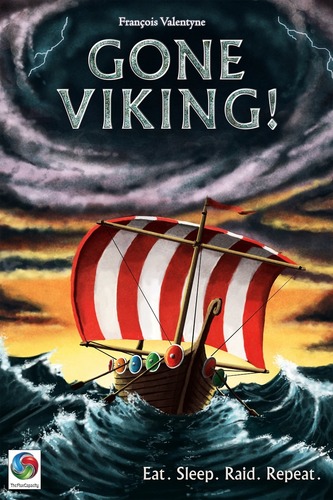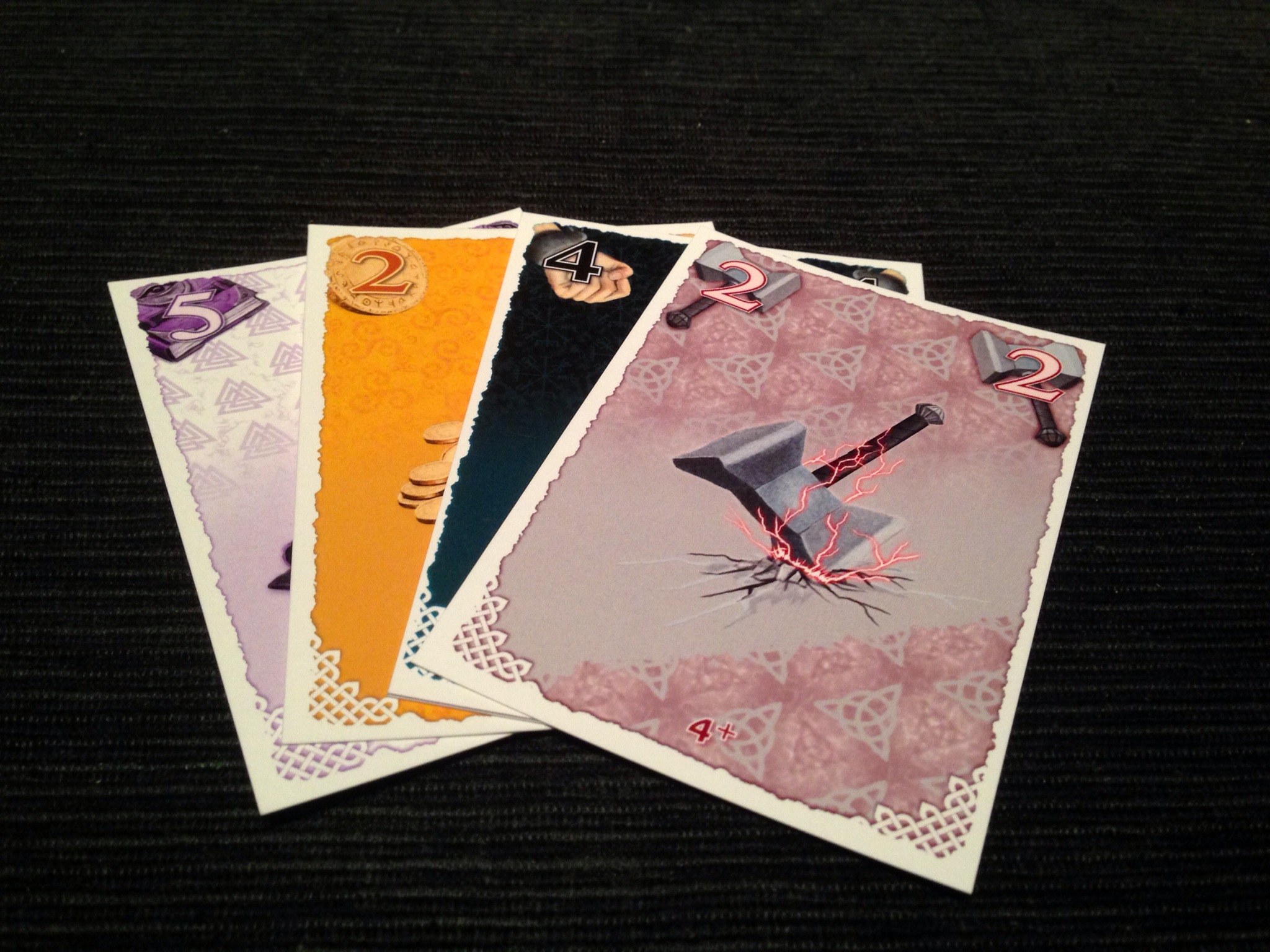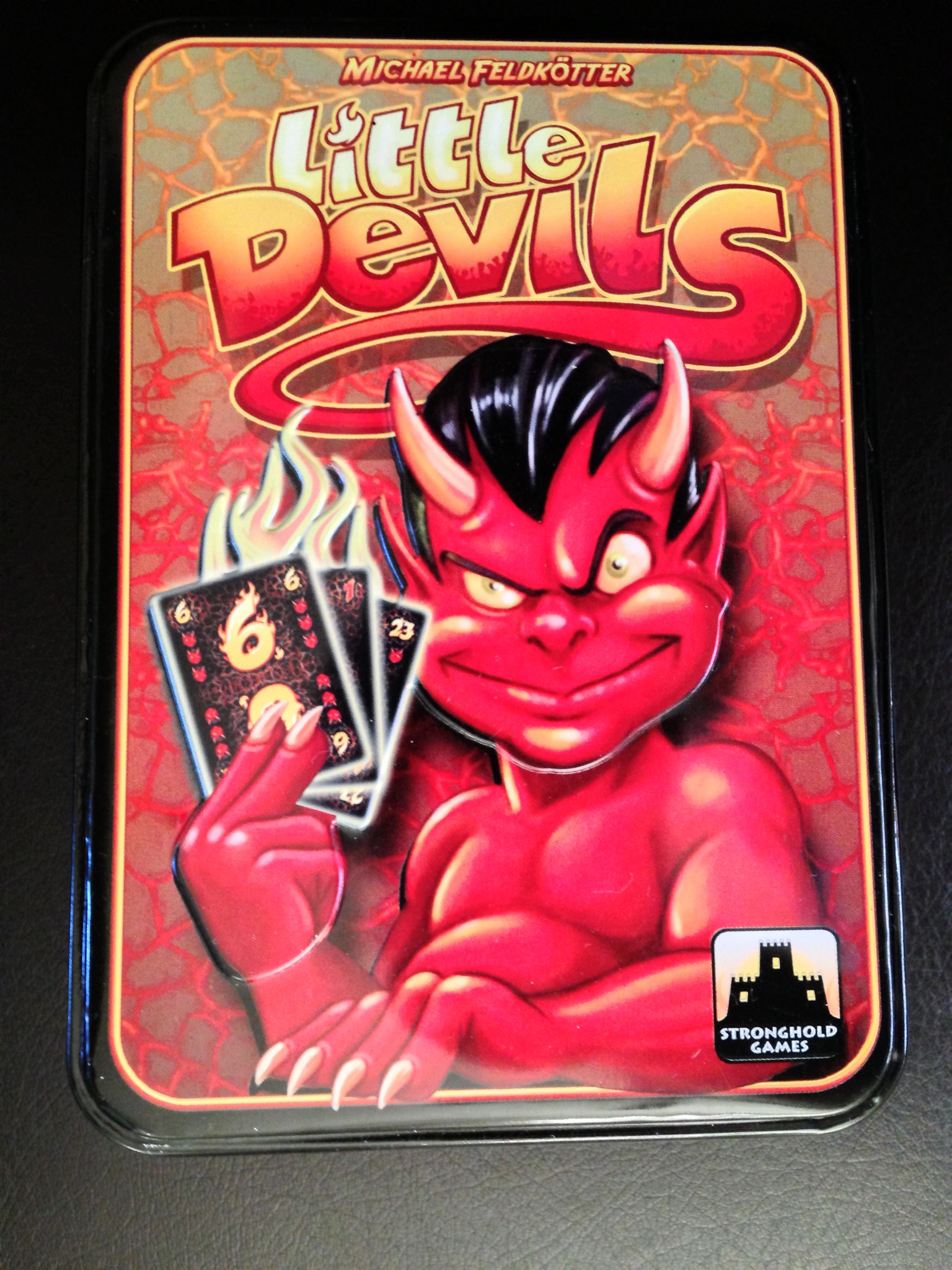Gone Viking!—A Double-Take Review
/ Vikings seem to be the new pirates. There are TV shows, an upcoming reprint of the great Kiesling game by that name, and now we're seeing a few new games added to the fray. Gone Viking! is a trick-taking game with a pantheon of twists on the genre. Is it a longboat of fun, or should it be sacked? Let's find out.
Vikings seem to be the new pirates. There are TV shows, an upcoming reprint of the great Kiesling game by that name, and now we're seeing a few new games added to the fray. Gone Viking! is a trick-taking game with a pantheon of twists on the genre. Is it a longboat of fun, or should it be sacked? Let's find out.
The Overview
Gone Viking! is a trick-taking game from Francois Valentyne (who designed the first Ticket to Ride Map Collection), for 3-5 players, ages 13+, that plays in 45-60 minutes. You'll be attempting to win tricks (and therefore wealth), which allows you to buy Ships. But if you're too wealthy, the Jarl will visit and expect some of your hard-earned plunder. The winner is the player who earns a certain number of Wealth tokens, depending on the number of players.
We received a prototype review copy, so the final pieces will definitely be better than these. And it's possible some gameplay will be tweaked.
The Components
54 Cards--These include 4 God cards, 48 Plunder cards (in four suits), 1 Jarl card, and 1 Trump Tracker card.
41 Wealth tokens--These include 5 Books, 6 Coins, 7 Hammers, 8 Fists, 10 Trees, and 5 Ships.
First, separate the Wealth tokens, and give each player two Tree tokens. Then you'll create the deck by adding and removing cards based on the number of players. Shuffle in the four God cards, and deal out a hand--the number of cards in the hand is also determined by the number of players. Then place the remaining cards into the center as a draw pile. Use the Jarl card to cover the suits that aren't trump; on the first turn trump is set to Books. Select a start player--called the Raid Leader. Now you're ready to play!
The Gameplay
The first thing you can do is swap out cards. In turn order, each person can choose to pay one of your Wealth tokens to swap up to two cards with two new ones. You can do this as often as you want (and can afford).
Now you go raiding--which is the part where you play out the hand and win tricks. The Raid Leader plays one or more cards of the same suit. If you choose to play more than one card, you combine the numbers to determine the number you've played down. So a 7 is the same as someone playing a 5 and a 2. As with many trick-taking games, play goes clockwise, and each player has to follow suit if they're able. If they're not able, they're free to play any card--including trump if the led suit wasn't trump.
Once everyone has played, the person who played the highest card of the led suit wins the trick—unless someone played trump, in which case the highest played trump wins. If there is a tie, then no one wins the trick and the cards are simply discarded. The winner takes a Wealth token of the type used to win the trick—and if none of that type are left, the winner takes a Tree token.
The winner leads the next trick. Continue on this way until everyone is out of cards. Because you can play more than one card on a trick to "boost" it's power, some people might run out of cards earlier than others. If that happens, the person just passes.
 There are four God cards, which are the highest numbers in each of the four suits. You can play these in one of two ways. You can play it as a "regular" card, and you simply count the value on the card. If you play it with another card of the God's suit, you can play it as a God card. You play the other card(s) as usual, but place the God facedown. Once the trick is fully resolved, the God card is flipped over. If there was already a God card in play, the new one replaces the old one, which is discarded. A God card can never be played as a God card by itself—it must always be played with another card of the same suit.
There are four God cards, which are the highest numbers in each of the four suits. You can play these in one of two ways. You can play it as a "regular" card, and you simply count the value on the card. If you play it with another card of the God's suit, you can play it as a God card. You play the other card(s) as usual, but place the God facedown. Once the trick is fully resolved, the God card is flipped over. If there was already a God card in play, the new one replaces the old one, which is discarded. A God card can never be played as a God card by itself—it must always be played with another card of the same suit.
Each God card has a Raid Power, and a Home Power. The Raid Power takes effect as soon as the card is flipped over, and the Home Power kicks in for a God card that survives until the end of the round.
Odin (Books)
Raid Power: Immediately choose trump, and no boosting is allowed (only single cards can be played).
Home Power: You gain two additional Wealth tokens from the supply when the round is over.
Freya (Coins)
Raid Power: Choose trump if there is none, and any player who wins a trick also gains one Coin token from the supply.
Home Power: All other players must return one Wealth token of their choice to the supply.
Thor (Hammers)
Raid Power: Removes trump, and players aren't forced to follow suit. The highest value card(s) take the trick.
Home Power: You can return any four Wealth tokens in exchange for a Ship token. (I'll explain that shortly.)
Loki (Fists)
Raid Power: He doesn't affect trump, and the lowest-valued cards win the trick.
Home Power: Gain one Wealth token from the supply or steal one from another player—but you can't steal a Ship).
When the hand is played out, three things happen in this order.
First, you apply the Home Power of the last God card standing.
Second you build a Ship if you can. You can turn in one of each type of Wealth token—or four Tree tokens—in exchange for a Ship token. This can only be done once per turn.
Third, the Jarl visits the player who has the most Wealth. Each Wealth token is worth one point, and each Ship is worth four points. If there's a tie, count up the value of all Fist cards won during that round, and whoever has the most among the tied players breaks the tie and receives the visit. The Jarl will take half of a person's Wealth tokens, rounded up. Ship tokens are safe from the Jarl's visit, however...
Next you'll see if someone has won. With 5 players you need seven or more Wealth tokens; with 4 you need eight or more; and with 3 players you need nine or more—keeping in mind Ships are worth four.
If no one wins, the player targeted by the Jarl becomes the new Raid Leader, gathers up all the cards, and deals out a new hand. The new Raid Leader also gets a free swap of up to four cards, and gets to choose trump.
If there's a tie for winning the game, whoever among the tied is the new Raid Leader wins.
The Verdict
Firestone—I'm a big fan of trick-taking games. I'm not terribly good at them, but I really, really like them. So a new one with some cool twists definitely caught my eye. Gone Viking! doesn't stray too far from the familiar formula, but has enough unique aspects to make it a good addition to the genre.
Jeremiah— I have a specific set of friends who love trick-taking games, and I enjoy them myself. Euchre is—from what I hear—an Ohio phenomenon; while other areas of the country play the game, it's rampant here. I enjoy it, but I don't like how often the fifth trick is a throwaway trick, or that if you have the lead and both bowers and the ace of the trump suit you can basically lay down three cards and be assured at least one point for the hand. Gone Viking adds a greater margin for strategic error, and causes the player to think things through, while adding fun and interesting twists along the way!
Firestone—There are some interesting choices to make here. "Do I play a God card as a high suit, or as the God card for its power?" "I want to take as many tricks as possible, but one fewer trick than some other player, so the Jarl visits him instead of me. How can I accomplish that?" I like when plays aren't obvious, and they don't seem to be here. God cards are cool and powerful, but it's definitely not something where you always want to play one if you can. Some of their powers will guarantee a visit from the Jarl. And the Boosting mechanism is cool, too. You can play extra cards to win a trick, but it will keep you from winning one other trick every time you do it.
Jeremiah— Yes, everything you just said is why I like this game. The mechanisms of the game allow for decision-making rather than funneling you into one base strategy. Using the God cards to alter/reverse/remove trump add a good level of chaos, but also evens the playing field, especially if the front-runner chose trump and happens to have a great hand dealt to them. I really enjoyed the fact that the chaos in the game only served to balance the game—it wasn't simply chaos for chaos' sake. Mind you, I enjoy games with heaps of chaos driving them, but this game doesn't need that type of chaos, so it works well! It should also be noted that Boosting is a great way to ensure you score that one token you need to build a Ship, protecting your wealth from the Jarl; it's another strategic decision to make on how you play your hand.
Firestone—The Jarl mechanism seemed harsh at first—and it is! But it's a good way to reign in the leader and give other people a chance. Plus both the Jarl and the grab-a-Tree-if-the-token-is-gone mechanisms keep people from hoarding.
Jeremiah— Yep, the elements that may seem chaotic or harsh have been well-thought-out and keep the game balanced, but they don't needlessly prolong the game or the inevitable; there's plenty of room for players to catch up, and for the lead to be exchanged between players.
Firestone—The one thing that keeps this from being a great trick-taking game for me is that you're not playing with all of the cards every hand. I like to know exactly what's out there. Sure, I don't know which player has what cards. And I have a crappy memory, so I usually screw up keeping track of what's been played anyway. But I don't want to have to wonder if the card is still in the draw pile. I know the draw pile, and the ability to swap some cards at the beginning, is part of the unique gameplay here, but part of the fun of trick-taking games is playing whatever hand you're dealt as well as you can. That's not really possible when there are a number of unknown cards still in a draw pile. I want control, and I don't have as much as I want here.
Jeremiah— Sheesh! Suffer from megalomania much? I get what you're saying, but from my point of view, the most frustrating thing about trick taking games is getting dealt a terrible hand and sitting there, having to take it while someone else runs roughshod over the rest of the table and having absolutely no power to stop them. It's a wasted hand, and it is terrible! Being able to swap cards alleviates some of this. True, you may still end up with a hand full of poopy cards, and it is costly, but it's a calculated risk; to me it gives the player more control than I'm used to having in a trick-taking game, and I like that, a lot.
Jeremiah's Final Verdict— There is something familiar to most casual/non-gamers about trick-taking games. Most people have played Hearts, Spades, or Euchre. I remember playing my first game of Hearts at a very young age. Gone Viking takes age-old mechanics and weaves them into an interesting, but not overbearing, theme, and adds some nice depth, creating a much less abstract experience—while mitigating some of my major frustrations with the typical trick-taking game. This is a really fun, light-weight game, so I say: Put this game on your table!
Firestone's Final Verdict—Despite my lack-of-control problem, I liked Gone Viking! This would be a great game to bust out with some friends who have played Spades or Euchre and are looking for something new to try. It's not heavy, but it's not too light, either. There are some neat and unique mechanisms that force you to think through choices. I like that.
Thanks so much for reading. Gone Viking! is on Kickstarter right now, and they're already over halfway to their modest goal.
We'd like to thank The Flux Capacity for providing review copies of Gone Viking! This in no way affected our opinions on the game; this was not a paid preview.
You can subscribe to TOG by filling in your email over on the right, we'd also love to connect with you on Facebook, Twitter, Instagram, YouTube and of course there's more TOG where this came from on our Podcast!




















